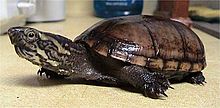Kinosternon
| Kinosternon | |
|---|---|

| |
| Mississippi mud turtle Kinosternon subrubrum hippocrepis | |
| Scientific classification | |
| Domain: | Eukaryota |
| Kingdom: | Animalia |
| Phylum: | Chordata |
| Class: | Reptilia |
| Order: | Testudines |
| Suborder: | Cryptodira |
| Superfamily: | Kinosternoidea |
| Family: | Kinosternidae |
| Subfamily: | Kinosterninae |
| Genus: | Kinosternon Spix, 1824[1] |
Kinosternon is a genus of small aquatic turtles from the Americas known commonly as mud turtles.
Geographic range
[edit]They are found in the United States, Mexico, Central America, and South America. The greatest species richness is in Mexico, and only three species (K. dunni, K. leucostomum, and K. scorpioides) are found in South America.

Description
[edit]They are very similar to the musk turtles, but generally smaller in size, and their carapaces are not as highly domed.
Diet
[edit]All mud turtles are carnivorous, consuming various aquatic invertebrates (especially molluscs and worms[2]) , fish, and even carrion.
Behavior
[edit]Mud turtles live in the ground layer on the bed of bodies of slowly-flowing or still water. By burrowing deeply into mud, mud turtles are protected from danger. They occasionally like to bask in the sun.[2]



Species
[edit]Extant
[edit]- Central Chiapas mud turtle - K. abaxillare (Baur, 1925)
- Tabasco mud turtle - K. acutum Gray, 1831[1]
- Alamos mud turtle - K. alamosae Berry & Legler, 1980[1]
- Central American mud turtle - K. angustipons Legler, 1965[1]
- Striped mud turtle - K. baurii (Garman, 1891)[1]
- Jalisco mud turtle - K. chimalhuaca Berry, Seidel, & Iverson, 1996[1]
- Cora mud turtle - K. cora Loc-Barragán et al., 2020[3]
- Creaser's mud turtle - K. creaseri Hartweg, 1934[1]
- Dunn's mud turtle - K. dunni Schmidt, 1947[1]
- Durango mud turtle - K. durangoense Iverson, 1979[1]
- Yellow mud turtle - K. flavescens (Agassiz, 1857)[1]
- Herrera's mud turtle - K. herrerai Stejneger, 1925[1]
- Rough-footed mud turtle - K. hirtipes (Wagler, 1830)[1]
- Valley of Mexico mud turtle - K. h. hirtipes (Wagler, 1830)[1]
- Lake Chapala mud turtle - K. h. chapalaense Iverson, 1981[1]
- San Juanico mud turtle - K. h. magdalense Iverson, 1981[1]
- Viesca mud turtle - K. h. megacephalum Iverson, 1981 (extinct)[1]
- Mexican plateau mud turtle - K. h. murrayi Glass and Hartweg, 1951[1]
- Patzcuarco mud turtle - K. h. tarascense Iverson, 1981[1]
- Mexican mud turtle - K. integrum (LeConte, 1954)[1]
- White-lipped mud turtle - K. leucostomum A.M.C. Duméril, Bibron & A.H.A. Duméril, 1851[1]
- Pacific red-cheeked mud turtle - K. mexicanum Iverson & Berry, 2024[4]
- Oaxaca mud turtle - K. oaxacae Berry & Iverson, 1980[1]
- Scorpion mud turtle - K. scorpioides (Linnaeus, 1766)[1]

Red-cheeked mud turtle - K. scorpioides cruentatum - White-throated mud turtle - K. s. albogulare (A.H.A. Duméril and Bocourt, 1870)[1]
- Red-cheeked mud turtle - K. s. cruentatum (A.M.C. Duméril, Bibron & A.H.A. Duméril, 1851)[1]

Sonora mud turtle - K. sonoriense - Florida mud turtle - K. steindachneri (Siebenrock, 1906)[5]
- Arizona mud turtle - K. stejnegeri Gilmore, 1923[1][6]
- Eastern mud turtle - K. subrubrum (Bonnaterre, 1789)[1]
- Vallarta mud turtle - K. vogti López-Luna et al., 2018[7]
Extinct
[edit]- †Kinosternon arizonense Gilmore, 1923 (known from Plio-Pleistocene fossil remains, formerly considered conspecific with K. stejnegeri)[1][6]
- †Kinosternon notolophus Bourque, 2016
- †Kinosternon pannekollops Bourque, 2016
- †Kinosternon pojoaque
- †Kinosternon rincon Bourque, 2016
- †Kinosternon skullridgescens
- †Kinosternon wakeeniense Bourque, 2016
References
[edit]- ^ a b c d e f g h i j k l m n o p q r s t u v w x y z aa ab ac ad ae af ag ah ai Rhodin 2010, p. 000.95-000.98
- ^ a b Obst, Fritz Jürgen (1986). Turtles, Tortoises, and Terrapins (1 ed.). New York: St. Martin's Press. p. 112. ISBN 0-312-82362-2.
- ^ Loc-Barragán, Jesús A.; Reyes-Velasco, Jacobo; Woolrich-Piña, Guillermo A.; Grünwald, Christoph I.; Anaya, Myriam Venegas De; Rangel-Mendoza, Judith A.; López-Luna, Marco A. (27 November 2020). "A New Species of Mud Turtle of Genus Kinosternon (Testudines: Kinosternidae) from the Pacific Coastal Plain of Northwestern Mexico". Zootaxa. 4885 (4): 509–529. doi:10.11646/zootaxa.4885.4.3. PMID 33311258.
- ^ Iverson, J. B., & Berry, J. F. (2024). Morphometric Variation in the Red-Cheeked Mud Turtle (Kinosternon cruentatum) and its Taxonomic Implications. Chelonian Conservation and Biology: Celebrating 25 Years as the World’s Turtle and Tortoise Journal.https://doi.org/10.2744/CCB-1589.1
- ^ Rhodin, Anders G.J.; Inverson, John B.; Roger, Bour; Fritz, Uwe; Georges, Arthur; Shaffer, H. Bradley; van Dijk, Peter Paul (August 3, 2017). "Turtles of the world, 2017 update: Annotated checklist and atlas of taxonomy, synonymy, distribution, and conservation status(8th Ed.)" (PDF). Chelonian Research Monographs. 7. ISBN 978-1-5323-5026-9. Retrieved October 4, 2019.
- ^ a b McCord, Robert D. (2016-02-17). "What is Kinosternon arizonense?". Historical Biology. 28 (1–2): 310–315. Bibcode:2016HBio...28..310M. doi:10.1080/08912963.2015.1053879. ISSN 0891-2963. S2CID 85572922.
- ^ López-Luna, Marco A.; Cupul-Magaña, Fabio G.; Escobedo-Galván, Armando H.; González-Hernández, Adriana J.; Centenero-Alcalá, Eric; Rangel-Mendoza, Judith A.; Ramírez-Ramírez, Mariana M.; Cazares-Hernández, and Erasmo. "A Distinctive New Species of Mud Turtle from Western México". Chelonian Conservation and Biology. 2018.
- Bibliography
- Rhodin, Anders G.J.; van Dijk, Peter Paul; Iverson, John B.; Shaffer, H. Bradley (2010-12-14). "Turtles of the world, 2010 update: Annotated checklist of taxonomy, synonymy, distribution and conservation status" (PDF). Chelonian Research Monographs. 5. Archived from the original (PDF) on 2011-07-17.


